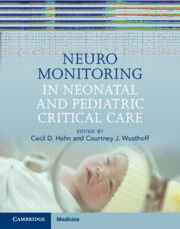Book contents
- Neuromonitoring in Neonatal and Pediatric Critical Care
- Reviews
- Neuromonitoring in Neonatal and Pediatric Critical Care
- Copyright page
- Contents
- Contributors
- Acknowledgements
- Part I General Considerations in Neuromonitoring
- Chapter 1 Overview of Continuous EEG Monitoring in Critically Ill Neonates and Children
- Chapter 2 Technical Aspects of Neurophysiological Monitoring
- Chapter 3 Logistics of Neuromonitoring
- Chapter 4 Nursing Considerations in Neuromonitoring
- Chapter 5 Normal Neurophysiology, Benign Findings, and Artifacts
- Chapter 6 Abnormal EEG in the Intensive Care Unit
- Part II Practice of Neuromonitoring: Neonatal Intensive Care Unit
- Part III Practice of Neuromonitoring: Pediatric Intensive Care Unit
- Part IV Practice of Neuromonitoring: Cardiac Intensive Care Unit
- Part V Cases
- Index
- References
Chapter 6 - Abnormal EEG in the Intensive Care Unit
from Part I - General Considerations in Neuromonitoring
Published online by Cambridge University Press: 08 September 2022
- Neuromonitoring in Neonatal and Pediatric Critical Care
- Reviews
- Neuromonitoring in Neonatal and Pediatric Critical Care
- Copyright page
- Contents
- Contributors
- Acknowledgements
- Part I General Considerations in Neuromonitoring
- Chapter 1 Overview of Continuous EEG Monitoring in Critically Ill Neonates and Children
- Chapter 2 Technical Aspects of Neurophysiological Monitoring
- Chapter 3 Logistics of Neuromonitoring
- Chapter 4 Nursing Considerations in Neuromonitoring
- Chapter 5 Normal Neurophysiology, Benign Findings, and Artifacts
- Chapter 6 Abnormal EEG in the Intensive Care Unit
- Part II Practice of Neuromonitoring: Neonatal Intensive Care Unit
- Part III Practice of Neuromonitoring: Pediatric Intensive Care Unit
- Part IV Practice of Neuromonitoring: Cardiac Intensive Care Unit
- Part V Cases
- Index
- References
Summary
The abnormal electroencephalogram (EEG) that attracts the most attention is that showing a seizure. In the intensive care unit (ICU), EEG monitoring is most commonly used for seizure detection; however, EEG can provide additional useful information. The background pattern can be used to evaluate encephalopathy and to assess cerebral function in patients who are sedated and paralyzed. EEG background can inform prognostication after hypoxic ischemic injury. EEG can serve as an ancillary investigation in the determination of brain death. Finally, EEG changes guide titration of treatments, such as continuous infusions administered for status epilepticus or increased intracranial pressure. Quantitative EEG (QEEG) is increasingly used by bedside clinicians for rapid assessment of cerebral function and facilitation of rapid interventions for critically ill patients.
Keywords
- Type
- Chapter
- Information
- Neuromonitoring in Neonatal and Pediatric Critical Care , pp. 76 - 102Publisher: Cambridge University PressPrint publication year: 2022

